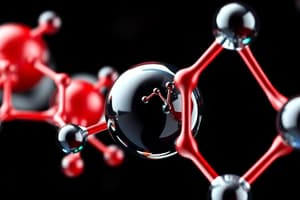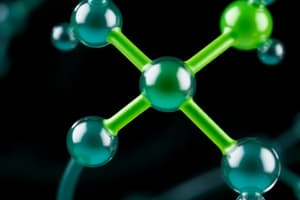Podcast
Questions and Answers
What are the basic components of an atom?
What are the basic components of an atom?
Protons, neutrons, and electrons.
Define a compound with an example.
Define a compound with an example.
A compound is a substance formed from two or more elements chemically bonded together, such as H2O.
What is the primary characteristic of a solid state of matter?
What is the primary characteristic of a solid state of matter?
A solid has a definite shape and volume.
What type of bond is formed by the sharing of electrons?
What type of bond is formed by the sharing of electrons?
What does the Law of Conservation of Mass state?
What does the Law of Conservation of Mass state?
What is the pH scale range for neutral solutions?
What is the pH scale range for neutral solutions?
How are elements organized in the periodic table?
How are elements organized in the periodic table?
What happens during a decomposition reaction?
What happens during a decomposition reaction?
Flashcards are hidden until you start studying
Study Notes
Basic Concepts in Chemistry
-
Atoms:
- Basic unit of matter.
- Composed of protons, neutrons, and electrons.
-
Elements:
- Pure substances made of only one type of atom.
- Represented by symbols on the periodic table (e.g., H for hydrogen, O for oxygen).
-
Compounds:
- Substances formed from two or more elements chemically bonded together (e.g., H2O, CO2).
-
Molecules:
- Two or more atoms bonded together, can be the same or different (e.g., O2, H2O).
States of Matter
-
Solid:
- Definite shape and volume.
- Particles are closely packed and vibrate in place.
-
Liquid:
- Definite volume but takes the shape of the container.
- Particles are closely packed but can move past each other.
-
Gas:
- No definite shape or volume.
- Particles are far apart and move freely.
Chemical Bonds
-
Ionic Bonds:
- Formed through the transfer of electrons from one atom to another.
- Typically occurs between metals and nonmetals.
-
Covalent Bonds:
- Formed by the sharing of electrons between atoms.
- Usually occurs between nonmetals.
-
Metallic Bonds:
- Involves the pooling of electrons among a lattice of metal atoms.
Chemical Reactions
-
Types of Reactions:
- Synthesis: Combining substances to form a new compound (A + B → AB).
- Decomposition: Breaking down a compound into simpler substances (AB → A + B).
- Single Replacement: One element replaces another in a compound (A + BC → AC + B).
- Double Replacement: Exchange of ions between two compounds (AB + CD → AC + BD).
- Combustion: Reaction with oxygen, producing energy (usually CO2 and H2O as products).
-
Law of Conservation of Mass:
- Mass is neither created nor destroyed in a chemical reaction.
Acids and Bases
-
Acids:
- Substances that donate protons (H+) in aqueous solution.
- Taste sour and turn blue litmus paper red.
-
Bases:
- Substances that accept protons or donate hydroxide ions (OH-) in aqueous solution.
- Taste bitter and turn red litmus paper blue.
-
pH Scale:
- Measures the acidity or basicity of a solution.
- Scale ranges from 0 (strongly acidic) to 14 (strongly basic), with 7 being neutral.
The Periodic Table
-
Organization:
- Elements are arranged in order of increasing atomic number.
- Rows are called periods; columns are groups or families.
-
Trends:
- Reactivity: Increases for metals down a group; decreases for nonmetals.
- Electronegativity: Increases across a period and decreases down a group.
Key Concepts in Thermodynamics
-
Endothermic Reactions:
- Absorb heat from the surroundings.
-
Exothermic Reactions:
- Release heat to the surroundings.
-
Activation Energy:
- Minimum energy needed to start a chemical reaction.
Stoichiometry
-
Mole Concept:
- A mole is 6.022 x 10^23 particles of a substance.
-
Molecular Weight:
- Sum of the atomic weights of all atoms in a molecule.
-
Balancing Equations:
- Ensure the number of atoms for each element is the same on both sides of the equation.
Basic Concepts in Chemistry
- Atoms are the fundamental units of matter, consisting of protons, neutrons, and electrons.
- Elements are pure substances represented by symbols on the periodic table, with each element made of only one type of atom (e.g., H for hydrogen, O for oxygen).
- Compounds are formed when two or more elements chemically bond together (e.g., water is H2O; carbon dioxide is CO2).
- Molecules consist of two or more atoms that can be identical or different, such as O2 (oxygen) and H2O (water).
States of Matter
- Solids have a definite shape and volume, with closely packed particles that vibrate in place.
- Liquids have a definite volume but take the shape of their containers, with particles that can move past one another.
- Gases lack a definite shape and volume, with particles that are far apart and move freely.
Chemical Bonds
- Ionic bonds result from the transfer of electrons between atoms, typically occurring between metals and nonmetals.
- Covalent bonds are formed by the sharing of electrons, usually between nonmetal atoms.
- Metallic bonds involve a shared pool of electrons among a lattice of metal atoms, allowing for conductivity and malleability.
Chemical Reactions
- Synthesis reactions involve combining substances to create a new compound (A + B → AB).
- Decomposition reactions break down compounds into simpler substances (AB → A + B).
- Single replacement reactions involve one element replacing another in a compound (A + BC → AC + B).
- Double replacement reactions exchange ions between two compounds (AB + CD → AC + BD).
- Combustion reactions typically involve the reaction with oxygen, producing energy along with carbon dioxide and water as byproducts.
- The Law of Conservation of Mass states that mass is neither created nor destroyed during a chemical reaction.
Acids and Bases
- Acids are substances that donate protons (H+) in aqueous solutions, typically tasting sour and turning blue litmus paper red.
- Bases accept protons or donate hydroxide ions (OH-) in aqueous solutions, tasting bitter and turning red litmus paper blue.
- The pH scale measures acidity or basicity, ranging from 0 (strongly acidic) to 14 (strongly basic), with 7 being neutral.
The Periodic Table
- Elements are arranged on the periodic table in order of increasing atomic number, with rows called periods and columns known as groups or families.
- Reactivity of metals increases as one moves down a group, while nonmetals show decreased reactivity.
- Electronegativity increases across a period and decreases down a group, affecting chemical bond formation.
Key Concepts in Thermodynamics
- Endothermic reactions absorb heat from their surroundings, while exothermic reactions release heat.
- Activation energy is the minimum energy required to start a chemical reaction, critical for the reaction to occur.
Stoichiometry
- A mole is defined as 6.022 x 10^23 particles of a substance, important for quantifying chemical reactions.
- Molecular weight is the total atomic weight of all atoms in a molecule, essential for calculations in chemistry.
- Balancing equations involves ensuring that the number of atoms for each element is identical on both sides of the reaction, maintaining mass conservation in chemical equations.
Studying That Suits You
Use AI to generate personalized quizzes and flashcards to suit your learning preferences.




